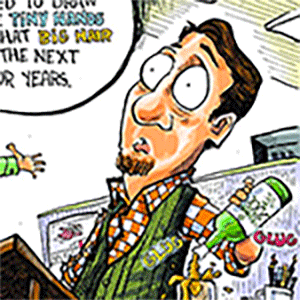Radioactive pollution still haunts Hunters Point in San Francisco
Published in News & Features
SAN FRANCISCO — More than a half century after the U.S. ignited 67 atomic weapons in the the central Pacific Ocean, a former Navy base in the Bay Area continues to carry that nuclear legacy.
Last week, residents were informed by the San Francisco Department of Health that a test taken in November 2024 at the former site of Hunters Point Naval Shipyard showed radiation levels of airborne Plutonium-239 had exceeded the Navy’s “action level,” requiring the military to further investigate.
The city and the residents were not informed until 11 months after that initial reading.
Hunters Point, a 500-acre peninsula jutting out into San Francisco Bay, served as a military laboratory to study the effects of nuclear weapons from 1946-69 following World War II. Although the research largely focused on how to decontaminate U.S. warships and equipment targeted with atomic bombs, the experimentation left much of the shipyard laced with radioactive contaminants and toxic chemicals.
For the last 30 years, the Navy has sought to clean up the area — now a U.S. Superfund site — with the long-term goal of redeveloping it into new housing and parkland.
But some Bay Area community leaders say haphazard remediation work and lackluster public outreach have endangered the health and safety of residents of the Bayview-Hunters Point neighborhood that sits beside the former shipyard. And they point to the Navy’s nearly year-long delay in informing them of the elevated Plutonium-239 reading, taken in November 2024, as just the latest example.
Plutonium-239 is a radioactive isotope and byproduct of nuclear bomb explosions. The elevated readings from November 2024 came from a 78-acre tract of land on the northeast portion of the shipyard, known as Parcel C.
“The City and County of San Francisco is deeply concerned by both the magnitude of this exceedance and the failure to provide timely notification,” wrote San Francisco Health Officer Susan Philip in an Oct. 30 letter to Navy officials. “Such a delay undermines our ability to safeguard public health and maintain transparency. Immediate notification is a regulatory requirement and is critical for ensuring community trust and safety.”
Navy officials and some health experts insist the radiation levels detected at the site, while above the Navy’s action level, did not pose an imminent or substantial threat to public health. Exposure to this level of Plutonium-239 every day for one year would be less than one-tenth the dose of radiation from a chest X-ray, according to a Navy spokesperson.
“The San Francisco Department of Public Health’s letter references a single outlier air sample that detected Plutonium-239 above the regulatory action level,” a Navy spokesperson said in a statement to the Los Angeles Times. “Regulatory action levels are deliberately and conservatively established below levels of health concern, and a single detection of Pu-239 at this level does not pose a risk to human health or public safety.”
The Navy said it has collected more than 200 ambient air monitoring samples from Parcel C since it began performing fieldwork there in 2023. The November 2024 sample was the only reading with elevated Plutonium-239, the Navy spokesperson told The Times.
Plutonium isotopes emit alpha radiation that is relatively benign outside the body, because it cannot travel through solid objects. However, if these radioactive particles are inhaled, they can damage the lungs and increase the long-term risk of developing certain cancers, according to the Centers for Disease Control and Prevention.
“What we generally are concerned about for alpha emitters is if you get them into your body, and either through inhalation, ingestion, inadvertent injection — like somebody gets a cut and it gets into their body,” said Kathryn Higley, a professor of nuclear science at Oregon State University.
But it’s the lack of transparency and the 11-month delay in reporting the reading that has fomented community mistrust and raised questions regarding the military’s competency to safely clean up the polluted shipyard. In 2000, the EPA admonished naval officials for neglecting to inform residents that a fire had broken out at a hazardous landfill at Hunters Point. In 2017, two employees of the consulting company Tetra Tech, who were hired by the Navy to assess radiation levels at Hunters Point, pleaded guilty to falsifying data in an effort to avoid having to perform additional cleanup on some areas of the shipyard.
The presence of radioactive air contaminants — at any level — compounds the health risks of the Bayview-Hunters Point neighborhood, which already faces high exposure to toxic diesel particles from big rigs traveling on nearby freeways and cargo ships visiting the Port of San Francisco.
Hunters Point Biomonitoring Foundation, a local nonprofit, has found concerning levels of toxic substances in urine screenings it has provided to several residents of the neighborhood, especially among older individuals and those living closer to the former Naval shipyard.
“Now, you’re talking about adding one of the most devastating radionuclides known to the human cardiopulmonary system to the chemical burden,” said Dr. Ahmisa Porter Sumchai, the foundation’s medical director and principal investigator.
“The particulate load is enough to kill people,” Sumchai added. “But you add ... a little Plutonium-239, and it’s a recipe for death.”
Philip, the San Francisco health officer, said in a statement that she met with Navy officials Oct. 31 and received assurances that air and dust monitoring is “ongoing” and that the military agency is “reviewing their duct control methods to ensure they are fully protective of public health.”
As a result, “no immediate action is required from a public health safety standpoint,” she said, adding that her office will continue to closely monitor the situation.
Other experts argued the situation was overblown. Phil Rutherford, a radiological risk expert and corporate consultant, called the delayed notification “unacceptable” but said the San Francisco health department’s letter was “ a storm in a teacup” considering the low levels of radioactive material.
Higley, the Oregon State professor, said the site’s long history of delays and scandals likely added to backlash from community members. “I understand (residents’) frustration that they want to see this place cleaned up so that they can safely use it,” Higley said. “And there’s been a lot of reasons for why this process takes so long. But, from a radiological perspective, the actual residual radioactivity at the site is pretty modest.”
In November 2024, a Navy contractor was grinding asphalt on the site — a construction project that, while unrelated to the site’s historical contamination, triggered the Navy to monitor for any air quality issues. One of its air samplers, in Parcel C — collected 8.16 times 10‐15 picocuries per milliliter of Plutonium-239 — twice the established action level — according to a Navy spokesperson.
Navy officials sent the sample to a lab for analysis, and the initial results came back in March 2025, showing high radiation levels. In April, they ordered the lab to reanalyze the sample. In the follow-up analysis, radiation levels of Plutonium-239 were below action levels.
Between May and September, the Navy “further investigated the test results and conducted a methodical review of the laboratory’s procedures and practices to ensure they complied with standards,” according to the Navy spokesperson. “A third party also conducted an analysis of the lab’s performance.”
Later that September, the Navy told the U.S. Environmental Protection Agency and several California state agencies about the elevated airborne radiation from Plutonium-239, in preparation for an upcoming community meeting. That information later trickled down to the San Francisco health department.
At some point, the Navy published some air quality data for Parcel C gathered between October and December 2024 on a website where it curates several environmental monitoring reports. That report only showed the lower Plutonium-239 radiation levels from the reanalysis were below the action level.
A Navy spokesperson told The Times that it was “mistakenly uploaded.”
“As soon as the Navy realized an incomplete report was uploaded, it was removed from the website,” the spokesperson said, while the Navy worked to verify the results.
All that has contributed to the confusion and concern among locals and advocates. Navy officials are expected to attend a Hunters Point Shipyard Citizens Advisory Committee Meeting on Nov. 17.
When fieldwork is occurring at the shipyard, the Navy monitors for Plutonium-239 and several other radioactive elements that may have resulted from historic fallout from atomic weapons testing.
Acquired by the Navy in 1940, Hunters Point was initially a base where ships were built, repaired and maintained during World War II. After the war ended, it became home to the Navy Radiological Defense Laboratory, a military research facility dedicated to investigating the effects of nuclear weapons and radiological safety.
The Navy bombarded a fleet of U.S. warships with nuclear weapons as a part of atomic testing in the Marshall Islands. The irradiated vessels were towed to Hunters Point, and used as the material and hardware upon which scientists tested decontamination methods.
In 1974, the shipyard was deactivated. Hazardous chemicals and low-level radiological contamination were identified, prompting the U.S. EPA to place the site on its Superfund list in 1989.
The Navy has led cleanup efforts, excavating contaminated soil and demolishing buildings. A largely residential parcel of the base, Parcel A, was turned over to San Francisco and has been redeveloped with new town houses and condos. A collective of 300 artists live and work in former naval buildings.
But dangers continue to emerge during ongoing remediation work.
In recent years, the Navy has recovered radioactive objects, including dials and deck markers coated with paint containing Radium isotopes to provide a glow-in-the-dark effect. Sumchai, medical director of the biomonitoring foundation, said she has observed large stockpiles of contaminated soil held in areas without any protective fencing to prevent contaminants from spreading off site.
“I view this as a local public health emergency,” Sumchai said. “I think that everything should be done to contain it and to remove people safely, if necessary, from documented areas of exposure.”
But to the casual observer the site looks unremarkable.
Hunters Point juts out into the San Francisco Bay just north of where Candlestick Park, the former home of the San Francisco Giants and 49ers, used to stand. Beyond the abandoned barracks and drydocks, the site is now mostly an empty expanse of grass and reeds, with an unobstructed view of the bay.
The cleanup sites, including Parcel C, are still fenced off, and only those with authorized credentials are allowed onto the property.
On a recent weekday afternoon, ravens flew and cawed over the long-vacant shipyard buildings, while construction crews and trucks ferried building equipment up and down Hill Drive — a steep road leading to brand new homes standing sentinel over the former shipyard.
And beyond waiting for a new batch of Navy reports, there was no way of knowing what’s in the air.
©2025 Los Angeles Times. Visit at latimes.com. Distributed by Tribune Content Agency, LLC.







Comments